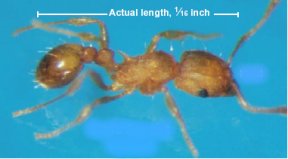A study of the insects called little fire ants may be as close as science gets to showing males and females as separate species.

Those species still share a name, Wasmannia auropunctata. The little fire ants live in seemingly unexceptional colonies with several queens, many sterile female workers, and a smaller number of males. Yet a genetic analysis shows that daughter queens are clones of their mother, says Denis Fournier of the Free University of Brussels in Belgium. And males manage their own unusual genetic tricks, so that eggs hatching into sons end up as clones of their fathers, Fournier and his colleagues report in the June 30 Nature.
Fournier says that the researchers discovered this arrangement by chance as they collected fire ant nests from various sites in French Guiana. W. auropunctata isn’t the imported red fire ant bedeviling the southern United States, but the little fire ant does sting and is spreading through the tropics to become a menace in its own right.
As the researchers studied DNA at 11 spots on little fire ant chromosomes, odd patterns emerged. In 33 out of 34 nests, queens within a particular nest matched each other’s genes. Yet the sterile workers’ genetic makeup didn’t match that of their queens but represented the sort of mix expected from sexual reproduction.
That pattern had been previously reported in only one other ant, Cataglyphis cursor.
Fournier proposes that because W. auropunctata males get shut out of parenting a queen, a countermeasure has evolved. During research on the species in New Caledonia, the team found that within a particular nest, genes of all males, including larval ones, matched each other and the genes in the sperm in the queens’ storage organs. The males’ genes, however, differed from the queens’ genes at 10 of the 11 comparison points. Therefore, male genes in some eggs probably got rid of the queens’ genes, says Fournier.
“Males thwart the queens by eliminating the female genome in [some] fertilized eggs,” he suggests. “We could think of the males as a separate, parasitic species that uses host eggs for its own reproduction.”
Genome elimination has turned up before—in some fish, amphibians, and insects—but in those cases, the females’ genes wipe out the males’.
Behavioral ecologist Andrew Bourke of the Zoological Society of London describes the idea of a male ant essentially cloning itself as “plausible.” If more studies confirm that the males’ genes eliminate the females’, the little fire ants provide “a very interesting example of sexual conflict,” he says.
Yet it’s not total war in the fire ant nest, points out another analyst of social insects. Both the males and queens need the sterile workers and apparently benefit from those workers’ genetic diversity, which comes from sex, notes Ross Crozier of James Cook University in Townsville, Australia.
There may be a battle between the fire ant sexes, says Crozier, but “even here they really still need each other.”







